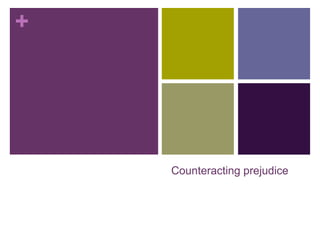
Apl08 reducing prejudice
- 2. + Some strategies: Contact hypothesis Spotlighting Value Conflicts Cognition Superordinate Goals Planned, Personal Experience of Discrimination
- 3. + Allport and the contact hypothesis: Argued that intergroup contact would only lead to decreased prejudice under the following four conditions: Equal status between groups in the situation Cooperative activity toward common goals Personalised acquaintance (“that leads to the perception of common interests and humanity”) Support for the contact by authorities or local norms
- 4. + Support Has received support in many studies, conducted in various situations and with stigmatised social groups (from foreign students to the elderly). Pettigrew and Tropp conducted a meta-analysis of 203 studies on intergroup contact as an influence on varied measures of prejudice. 94% of these studies found an inverse relationship between contact and prejudice. Findings also showed that the intergroup contact’s prejudice- reducing effects can generalise to new social situations, whole outgroups or to other outgroups
- 5. + Different models of contact 3 related, but different, views as to the most effective way to conduct intergroup contact interventions: 1) Decategorisation: initial ingroup-outgroup catergorisations are weakened and taken over by other cross-cutting similarities between members. E.g. that outgroup member is like me in doing, thinking, or feeling 2) Recategorisation: ingroup-outgroup categorisation is weakened by uniting both groups in a common superordinate identity. E.g. We are all Australians 3) Mutual differentiation: recommends maintaining the initial social catergory but explicitly emphasising that the groups are mutually interdependent. E.g. our groups are different, but we need to work together to accomplish this goal.
- 6. + Spotlighting Value conflicts & Cognition Spotlighting Value Conflicts Combines cognitive and motivational bases for reducing prejudice. Focused on showing inconsistencies in the person’s values. This engages their self-concept and often develops guilt motivation. Aims to motivate people to change their beliefs and behaviour in the direction of consistency with key underlying values such as fairness and equality. Cognition Educate people how to recognise the existence of their own prejudices and what they’re based on. Try and control automatic responses to prejudice in yourself.
- 7. + Superordinate Goals Create/identify a common goal for each group that is important and requires cooperation to achieve. E.g. Sustainable Peace Project – South Africa The project brings together ex-prisoners, police and army officers, victims, community leaders and business people. For a few days former enemies walk together in a place of unspoilt beauty, cross crocodile-infested rivers, sleep on the ground, and protect each other while on guard duty against dangerous animals. The friendship that grows out of this experience echoes similar results achieved with employing wilderness to bring South African ex-combatants together. Peace Through Music Project – Northern Ireland
- 8. + Planned, Personal Experience of Discrimination An interactive, experiential method Majority group members exposed to prejudice and discrimination that minority-group individuals undergo every day. Expectation: more empathy and better understanding of the problems of minorities. Jane Eliot’s Brown Eyes, Blue Eyes exercise...